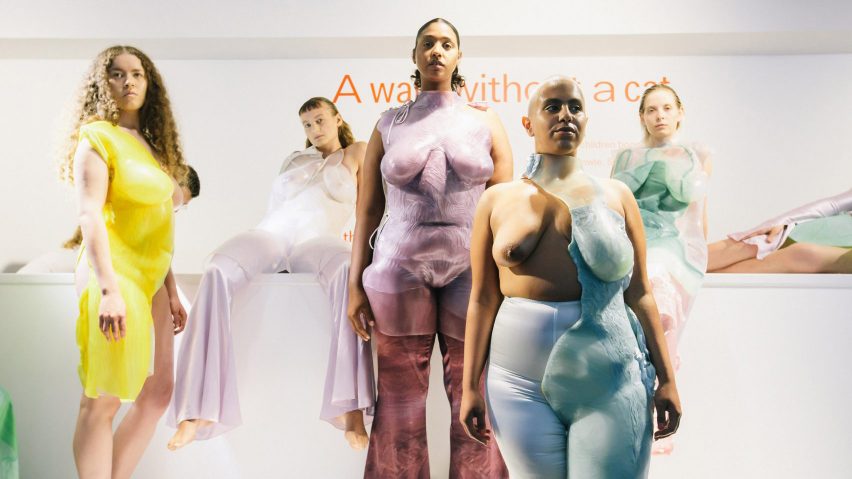Conceptual space wear and crystal accessories made from human sweat were presented by this year's Royal College of Art graduates from the fashion masters courses.
Taking place at London's 180 The Strand, this year's Royal College of Art (RCA) Fashion Show was titled A Walk Without a Cat.
Over 50 graduating students across womenswear, menswear, footwear, accessories, millinery and knitwear showcase a "physical, visual and sensory feast" of presentations, food, dance performances and installations.
"A Walk Without a Cat reinforces the Royal College of Art as the vanguard of fashion research, by focusing on three key areas of examination: material development, fashion systems and digital transformation," said Zowie Broach, head of fashion at the RCA.
"RCA Fashion holds a unique position at the junction between the creative arts, design and science, posing answers to question about fashion, identity and our future selves," she explained.
Here are our favourite designers from the 2018 show:
Sinead O'Dwyer
Sinead O'Dwyer looked to the toxic representation of the female form in fashion for her collection of silicone and fibreglass torsos covered in silk.
"My work seeks to challenge the continual usage of one body type to design from, fit in and show in," she told Dezeen. "It also addresses how this societal framework moulds the perception of one's own body and shapes how we perceive our own physical forms."
Alice Potts
For her collection, graduate Alice Potts created a series of garments encrusted in crystals made from human sweat, ranging from ballet shoes to a sports jersey.
"Every human is unique, and so is the sweat they produce, encapsulating our health, wellbeing and identity," Potts said. "In the future, I'm keen to develop the idea and use it to explore sustainable processes within fashion."
Alice Robinson
Graduate Alice Robinson centred her entire collection around a single sheep in Shropshire – number 11458. Documenting its life from birth to death in an abattoir, she used every inch of its body to create her line of leather accessories.
The leather was made into bags and shoes, while the wool was knitted into gloves and the bones were dipped in silver for jewellery. Finally, the meat was served to those attending the private view.
"The collection has been strongly influenced by a study into a consumer's future perception of luxury and the experience we gain from the consumption of animal products," she explained.
Anna Talvi
Using her previous education in mathematics and physics, Anna Talvi modelled her conceptual collection of clothing for life in space and microgravity environments.
"One of the biggest challenges is finding countermeasures to the substantial bone loss and muscle atrophy when living in space for longer periods of time," she said.
"In collaboration with researchers and medical doctors, I am developing an antagonist exomuscle bodysuit which is the core piece of this set. It helps to keep astronauts and space travellers bodies fit: minimise the bone loss and muscle atrophy."
Marie Lueder
Called Civilian, this collection portrays the "heteronormative wearer" with a series of leather, denim and rubber garments.
"My background is classic tailoring for menswear, which I was trained in at the state opera in Hamburg for three years. This taught me to shape the garments ideally onto the physiognomy of the wearer, which I use in every garment even its not classic suiting," she said.
Matic Veler
For his project, Matic Veler wanted to create an ornamental costume evocative of Christmas festivities and baroque-style architecture. Approximately two and a half metres tall, the sculptural garment is made of neoprene and laser cut in varying patterns.
"I always loved the different holiday celebrations throughout the year," he said. "For instance, Christmas: carrying unique and unmistakable scents and the beautiful ornaments surrounding the tree with the sparkles and magical atmosphere. Still, after all these years, my favourite holiday. It represents nostalgic, happy times."
Renata Brenha Ribeiro
Inspired by the rites and rituals of Latin America, this collection consists of sculptural garments made from textiles and foods.
"I've developed all my textiles, and worked with materials like cacao, blood and chillies," she said. "I am interested in how food can inform and form fabric."
Yuan-Lung Kao
This collection by Yuan-Lung Kao aims to "observe the society behind the screen". Featuring a combination of natural and synthetic yarns, the garments are loosely structured and centred around a circular shape.
"I am hoping that through my collection, the audience could gain a new perspective of how the society can be seen, yet in a different point of view," he said.

